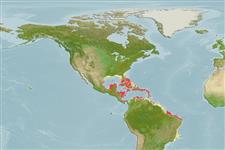>
Eupercaria/misc (Various families in series Eupercaria) >
Scaridae (Parrotfishes) > Scarinae
Etymology: Scarus: Greek, skaros = a fish described by anciente writers as a parrot fish; 1601 (Ref. 45335).
Eponymy: Paul Erdmann Isert (1756–1789) was a German botanist, also known for his opposition to the Danish-Norwegian slave trade. [...] (Ref. 128868), visit book page.
More on author: Bloch.
Environment: milieu / climate zone / djupintervall / distribution range
Ekologi
marina revassocierade; djupintervall 3 - 25 m (Ref. 9710). Subtropical; 23°C - 26°C (Ref. 130582); 33°N - 26°S, 98°W - 31°W
Western Atlantic: Bermuda, Florida (USA), Bahamas, and northeastern Gulf of Mexico to northern South America; throughout the Caribbean (Ref. 3802, 13628). Range probably extends to Brazil (Ref. 13628).
Length at first maturity / Size / Vikt / Age
Könsmognad: Lm ?, range 16 - ? cm
Max length : 35.0 cm TL hane/ej könsbestämd; (Ref. 9710); common length : 18.0 cm TL hane/ej könsbestämd; (Ref. 3802)
Taggstrålar i ryggfenan (totalt) : 9; Mjukstrålar i ryggfenan (totalt) : 10; Taggstrålar i analfenan: 3; Mjukstrålar i analfenan: 9. White stripe above upper dark stripe ends at gill opening; upper and lower caudal margins pale (Ref. 26938). Terminal phase males are blue-green and orange, chest and head pink below a green band at lower edge of eye; median fins with blue borders, the broad central parts orange with linear blue markings (Ref. 13442).
Body shape (shape guide): fusiform / normal.
Found over shallow, clear waters, generally over Thalassia beds (Ref. 13628). Also found rocky or coral areas (Ref. 13628). A schooling species. Feeds on plants. A protogynous hermaphrodite (Ref. 55367). Super males spawn individually with striped females, while sexually mature males in the striped phase spawn in aggregation.
Life cycle and mating behavior
Könsmognad | Reproduktion | Lek | Ägg | Fecundity | Larver
Diandric. Length at sex change = 9.6 cm TL (Ref. 55367). Forms harem groups composed of a single male and several smaller females (Ref. 55367).
Böhlke, J.E. and C.C.G. Chaplin, 1993. Fishes of the Bahamas and adjacent tropical waters. 2nd edition. University of Texas Press, Austin. (Ref. 5521)
IUCN Red List Status (Ref. 130435: Version 2025-1)
Threat to humans
Reports of ciguatera poisoning (Ref. 30911)
Human uses
Fiskeri: mindre kommeriell; Akvarium: Kommersiell
Verktyg
Special reports
Download XML
Internet-källor
Estimates based on models
Preferred temperature (Ref.
123201): 26.3 - 28.2, mean 27.4 °C (based on 645 cells).
Phylogenetic diversity index (Ref.
82804): PD
50 = 0.5000 [Uniqueness, from 0.5 = low to 2.0 = high].
Bayesian length-weight: a=0.01096 (0.00705 - 0.01705), b=3.01 (2.88 - 3.14), in cm total length, based on LWR estimates for this species & Genus-body shape (Ref.
93245).
Trofisk nivå (Ref.
69278): 2.0 ±0.0 se; based on diet studies.
Resiliens (Ref.
120179): Hög, lägsta populationsfördubblingstid mindre än 15 månader (Preliminary K or Fecundity).
Fishing Vulnerability (Ref.
59153): Low vulnerability (25 of 100).
🛈
Nutrients (Ref.
124155): Calcium = 36.8 [20.5, 68.6] mg/100g; Iron = 0.994 [0.617, 1.743] mg/100g; Protein = 19.4 [17.3, 21.2] %; Omega3 = 0.135 [0.077, 0.254] g/100g; Selenium = 10.9 [5.3, 21.4] μg/100g; VitaminA = 18.9 [4.6, 78.1] μg/100g; Zinc = 1.74 [1.18, 2.59] mg/100g (wet weight);
